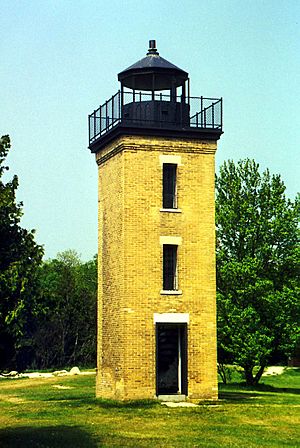Peninsula Point Light facts for kids
 |
|
| Peninsula Point Lighthouse | |
|
|
|
| Location | Stonington, Michigan |
|---|---|
| Coordinates | 45°40′06″N 86°58′00″W / 45.6682°N 86.9666°W |
| Year first constructed | 1865 |
| Year first lit | 1866 |
| Automated | 1922 |
| Deactivated | 1936 |
| Foundation | Natural emplaced |
| Construction | Brick |
| Tower shape | Square, decagonal lantern |
| Markings / pattern | Natural yellow with black parapet and lantern |
| Height | 40 feet (12 m) |
| Focal height | 40 feet (12 m) |
| Original lens | Oil lamp, 4th order Fresnel lens |
| Current lens | Removed |
| Range | 10 nautical miles; 19 kilometres (12 mi) |
| Characteristic | white flash every 30 seconds. |
| ARLHS number | USA-591 |
The Peninsula Point Light is a historic lighthouse located at the very end of the Stonington Peninsula in Bay de Noc township, Delta County, Michigan. For many years, official records have called it both Peninsula Point and Point Peninsula.
Contents
Why the Lighthouse Was Built
The Stonington Peninsula sticks out into Lake Michigan. This spot was very important for ships traveling to and from the docks in Escanaba and Gladstone. A dangerous shoal (a shallow area with rocks) stretches more than 2 miles (3.2 km) into the lake. This made shipping very risky.
The lighthouse had two main jobs:
- It showed ships where to turn safely.
- It warned sailors to stay away from the hidden rocks and shallow areas.
Many ships carried fish, iron ore, lumber, and other goods through these waters. The U.S. Government saw that a lighthouse was needed to help ships navigate around these dangerous areas. These areas were where Big Bay de Noc, Little Bay de Noc, and Green Bay of Lake Michigan met.
Building the Lighthouse
Money was first set aside to build the lighthouse in 1856. More funds were approved on July 20, 1864. The lighthouse was finally built in 1865, after the Civil War. It helped guide ships until 1934.
Lighthouse Keepers
The first person to take care of the Point Peninsula Light was Mr. Charles Beggs. He worked there until he passed away in 1887. After him, Mr. Henry Corgan became the keeper, followed by Mr. Peter Knutsen. In 1889, Captain James D. Armstrong became the keeper. He and his family lived at the lighthouse until 1922.
Automation and Deactivation
In 1922, the United States Lighthouse Service installed an automatic acetylene light. This new light replaced the old oil lamp that keepers had to operate by hand. Because the light was now automatic, a keeper was no longer needed to live at the site. Captain Armstrong was still in charge of Peninsula Point until 1931.
The old Fresnel lens was taken out and replaced with a smaller, 300-millimetre (12 in) lens. This new lens used an acetylene flasher and a special sun valve. The light's pattern changed to a 1-second flash followed by a nine-second dark period. This new light started working on May 20, 1922.
The Peninsula Point Light was turned off and left empty in 1936. This happened when the Minneapolis Shoal Light Station started working. Today, visitors can climb the cast iron spiral staircase inside the tower. At the top, you can enter the lantern room. The house where the lighthouse keeper lived burned down in 1959. This happened after it had been fixed up by the Grange in Stonington.
In 1937, the USDA-Forest Service took over the lighthouse. The Civilian Conservation Corps repaired the building and built public picnic areas. The Stonington Grange then took care of the lighthouse and its grounds. In 1949, the Grange even won first prize in a state contest for their work there. The house part of the lighthouse burned down completely in 1959. The USDA Forest Service cleared away the debris and fixed the tower in 1962.
Current Status
The Peninsula Point Lighthouse is listed on the National Register of Historical Places. This means it's recognized as an important historical site.
The lighthouse tower is managed by the National Forest Service. They have a webpage about the light and the picnic area.
Birds and Butterflies
Lighthouses are often built on points of land that are important for animal migrations. The Stonington Peninsula is a key spot for the migration of the monarch butterfly. In September, thousands of monarch butterflies gather here to rest. Then, they fly across Lake Michigan to Door County, Wisconsin. It's like a famous park called Point Pelee in Canada, but for the Upper Peninsula.
This area is also an important bird area for migratory birds. The Hiawatha National Forest has done a great job protecting this special place.
The rocky shoreline here is also a great place for rock hounds. You can find fossils that are thought to be 400 to 500 million years old!
Visiting the Lighthouse
The USDA Forest Service manages the grounds as a picnic area. There are ten picnic tables and grills around the tower. You'll find pit toilets and drinking water available.
The lighthouse tower is at the end of County Road 513. To get there, you turn off US 2, about 3 miles (4.8 km) east of Rapid River, Michigan. The road gets narrower and rougher as you go. But climbing the spiral staircase and seeing the view from the ten-sided tower is worth the trip! The view is said to be "spectacular," so bring your camera. The last mile of the road is not good for large recreational vehicles or trailers longer than 16 feet (4.9 m) or taller than 8 feet (2.4 m). There's a parking area for RVs at the start of the narrower road.


